Organizational Behaviour, Structure, and Leadership Report
VerifiedAdded on 2019/12/04
|14
|5297
|145
Report
AI Summary
This report delves into the realm of organizational behaviour, providing a comprehensive analysis of various organizational structures and cultures, and their impact on business performance. It examines the factors influencing individual behaviour within an organization, categorizing them into personal, environmental, and organizational factors. Furthermore, the report includes a letter to Mr. Smith, discussing different approaches to management and leadership, specifically focusing on the implications of autocratic and participative leadership styles. The impact of leadership styles over motivation theory is also evaluated, along with the practical application of motivational theories in the workplace. Finally, the report explores the nature of groups and their behaviour within organizations, including the factors that promote or inhibit teamwork and the impact of technology on team functioning. The report uses the case study of 'Scoops n' Smiles Ltd' to illustrate the concepts.
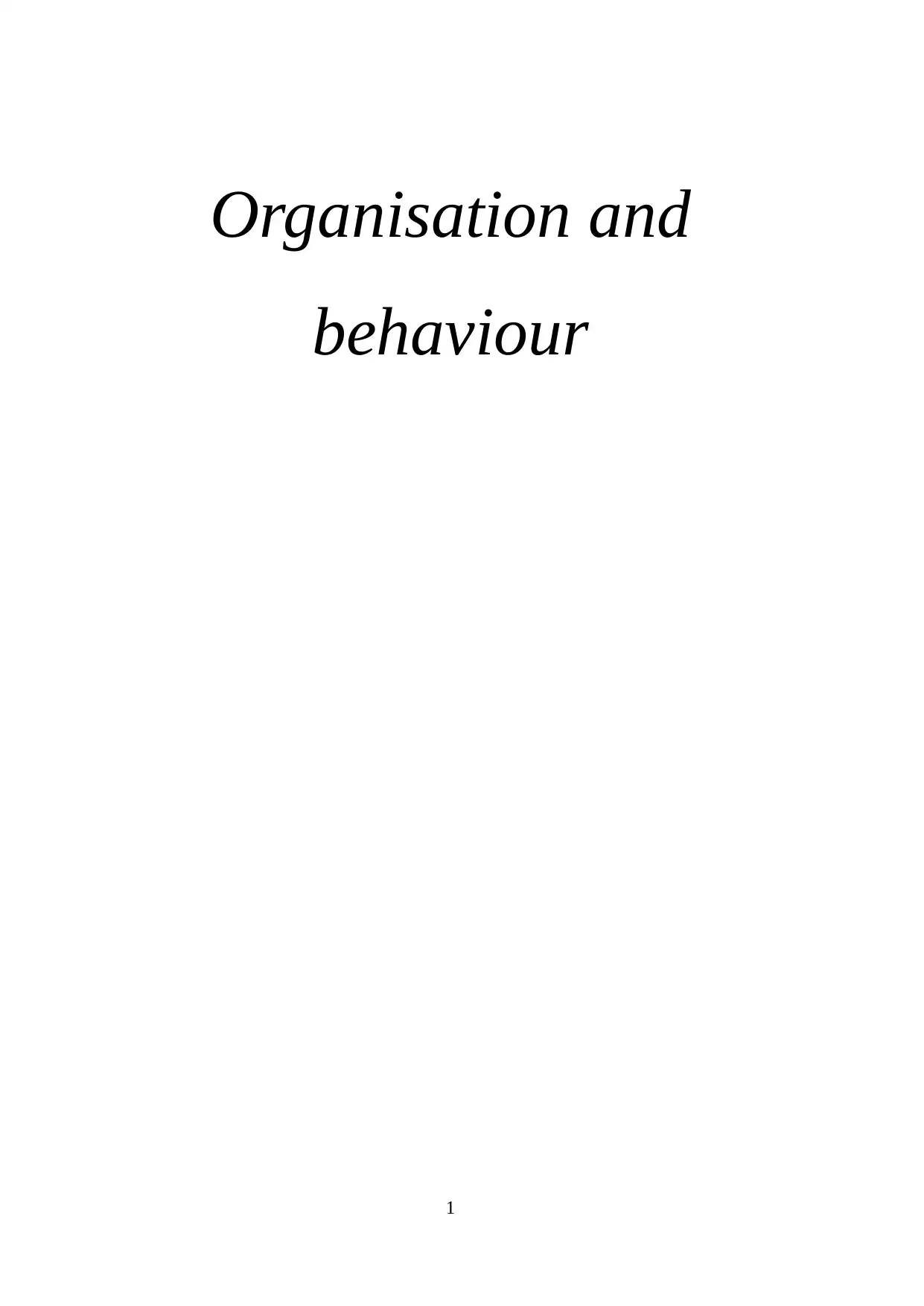
Organisation and
behaviour
1
behaviour
1
Paraphrase This Document
Need a fresh take? Get an instant paraphrase of this document with our AI Paraphraser
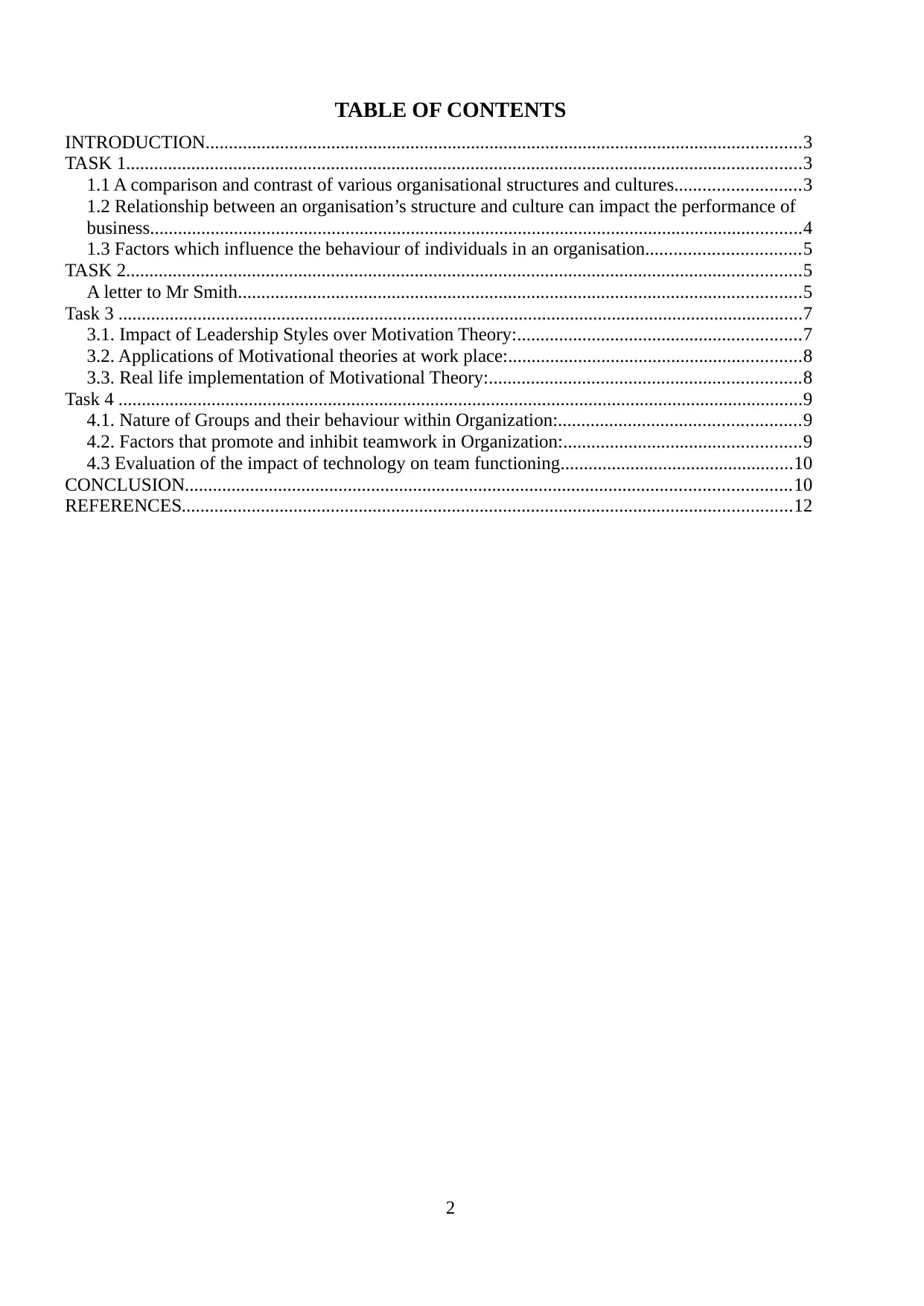
TABLE OF CONTENTS
INTRODUCTION................................................................................................................................3
TASK 1.................................................................................................................................................3
1.1 A comparison and contrast of various organisational structures and cultures...........................3
1.2 Relationship between an organisation’s structure and culture can impact the performance of
business............................................................................................................................................4
1.3 Factors which influence the behaviour of individuals in an organisation.................................5
TASK 2.................................................................................................................................................5
A letter to Mr Smith.........................................................................................................................5
Task 3 ...................................................................................................................................................7
3.1. Impact of Leadership Styles over Motivation Theory:.............................................................7
3.2. Applications of Motivational theories at work place:...............................................................8
3.3. Real life implementation of Motivational Theory:...................................................................8
Task 4 ...................................................................................................................................................9
4.1. Nature of Groups and their behaviour within Organization:....................................................9
4.2. Factors that promote and inhibit teamwork in Organization:...................................................9
4.3 Evaluation of the impact of technology on team functioning..................................................10
CONCLUSION..................................................................................................................................10
REFERENCES...................................................................................................................................12
2
INTRODUCTION................................................................................................................................3
TASK 1.................................................................................................................................................3
1.1 A comparison and contrast of various organisational structures and cultures...........................3
1.2 Relationship between an organisation’s structure and culture can impact the performance of
business............................................................................................................................................4
1.3 Factors which influence the behaviour of individuals in an organisation.................................5
TASK 2.................................................................................................................................................5
A letter to Mr Smith.........................................................................................................................5
Task 3 ...................................................................................................................................................7
3.1. Impact of Leadership Styles over Motivation Theory:.............................................................7
3.2. Applications of Motivational theories at work place:...............................................................8
3.3. Real life implementation of Motivational Theory:...................................................................8
Task 4 ...................................................................................................................................................9
4.1. Nature of Groups and their behaviour within Organization:....................................................9
4.2. Factors that promote and inhibit teamwork in Organization:...................................................9
4.3 Evaluation of the impact of technology on team functioning..................................................10
CONCLUSION..................................................................................................................................10
REFERENCES...................................................................................................................................12
2
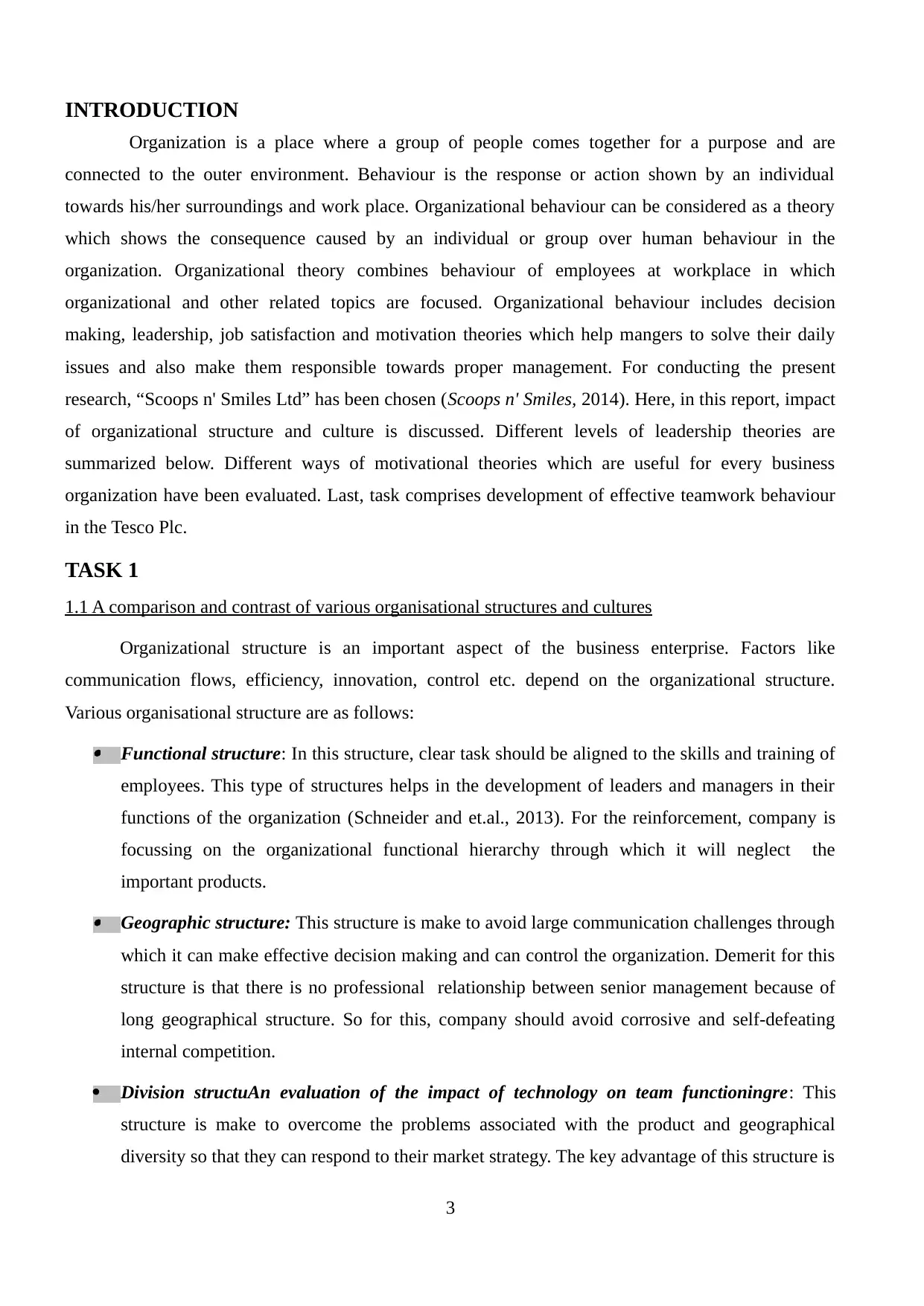
INTRODUCTION
Organization is a place where a group of people comes together for a purpose and are
connected to the outer environment. Behaviour is the response or action shown by an individual
towards his/her surroundings and work place. Organizational behaviour can be considered as a theory
which shows the consequence caused by an individual or group over human behaviour in the
organization. Organizational theory combines behaviour of employees at workplace in which
organizational and other related topics are focused. Organizational behaviour includes decision
making, leadership, job satisfaction and motivation theories which help mangers to solve their daily
issues and also make them responsible towards proper management. For conducting the present
research, “Scoops n' Smiles Ltd” has been chosen (Scoops n' Smiles, 2014). Here, in this report, impact
of organizational structure and culture is discussed. Different levels of leadership theories are
summarized below. Different ways of motivational theories which are useful for every business
organization have been evaluated. Last, task comprises development of effective teamwork behaviour
in the Tesco Plc.
TASK 1
1.1 A comparison and contrast of various organisational structures and cultures
Organizational structure is an important aspect of the business enterprise. Factors like
communication flows, efficiency, innovation, control etc. depend on the organizational structure.
Various organisational structure are as follows:
Functional structure: In this structure, clear task should be aligned to the skills and training of
employees. This type of structures helps in the development of leaders and managers in their
functions of the organization (Schneider and et.al., 2013). For the reinforcement, company is
focussing on the organizational functional hierarchy through which it will neglect the
important products.
Geographic structure: This structure is make to avoid large communication challenges through
which it can make effective decision making and can control the organization. Demerit for this
structure is that there is no professional relationship between senior management because of
long geographical structure. So for this, company should avoid corrosive and self-defeating
internal competition.
Division structuAn evaluation of the impact of technology on team functioningre: This
structure is make to overcome the problems associated with the product and geographical
diversity so that they can respond to their market strategy. The key advantage of this structure is
3
Organization is a place where a group of people comes together for a purpose and are
connected to the outer environment. Behaviour is the response or action shown by an individual
towards his/her surroundings and work place. Organizational behaviour can be considered as a theory
which shows the consequence caused by an individual or group over human behaviour in the
organization. Organizational theory combines behaviour of employees at workplace in which
organizational and other related topics are focused. Organizational behaviour includes decision
making, leadership, job satisfaction and motivation theories which help mangers to solve their daily
issues and also make them responsible towards proper management. For conducting the present
research, “Scoops n' Smiles Ltd” has been chosen (Scoops n' Smiles, 2014). Here, in this report, impact
of organizational structure and culture is discussed. Different levels of leadership theories are
summarized below. Different ways of motivational theories which are useful for every business
organization have been evaluated. Last, task comprises development of effective teamwork behaviour
in the Tesco Plc.
TASK 1
1.1 A comparison and contrast of various organisational structures and cultures
Organizational structure is an important aspect of the business enterprise. Factors like
communication flows, efficiency, innovation, control etc. depend on the organizational structure.
Various organisational structure are as follows:
Functional structure: In this structure, clear task should be aligned to the skills and training of
employees. This type of structures helps in the development of leaders and managers in their
functions of the organization (Schneider and et.al., 2013). For the reinforcement, company is
focussing on the organizational functional hierarchy through which it will neglect the
important products.
Geographic structure: This structure is make to avoid large communication challenges through
which it can make effective decision making and can control the organization. Demerit for this
structure is that there is no professional relationship between senior management because of
long geographical structure. So for this, company should avoid corrosive and self-defeating
internal competition.
Division structuAn evaluation of the impact of technology on team functioningre: This
structure is make to overcome the problems associated with the product and geographical
diversity so that they can respond to their market strategy. The key advantage of this structure is
3
⊘ This is a preview!⊘
Do you want full access?
Subscribe today to unlock all pages.

Trusted by 1+ million students worldwide
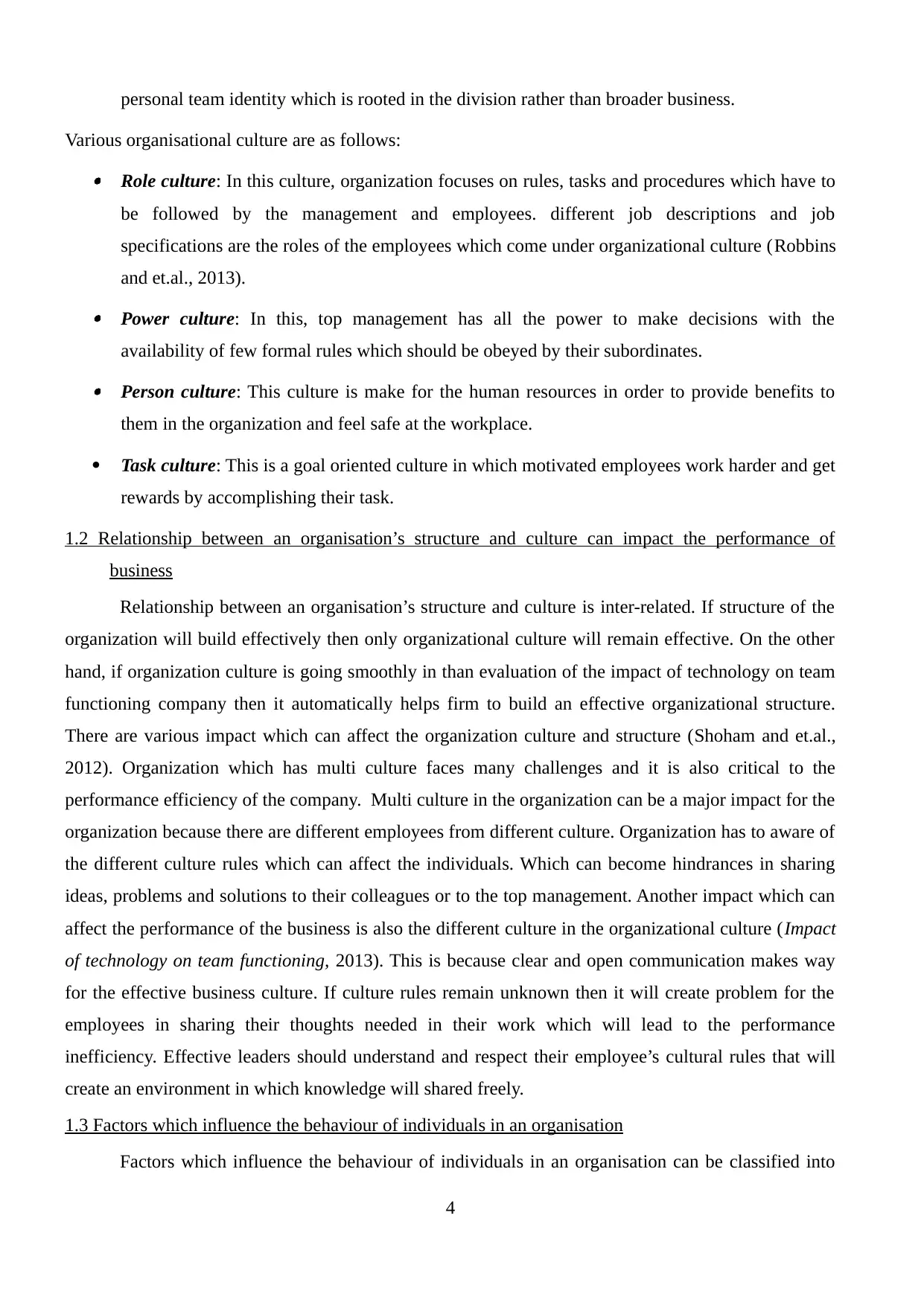
personal team identity which is rooted in the division rather than broader business.
Various organisational culture are as follows:
Role culture: In this culture, organization focuses on rules, tasks and procedures which have to
be followed by the management and employees. different job descriptions and job
specifications are the roles of the employees which come under organizational culture (Robbins
and et.al., 2013).
Power culture: In this, top management has all the power to make decisions with the
availability of few formal rules which should be obeyed by their subordinates.
Person culture: This culture is make for the human resources in order to provide benefits to
them in the organization and feel safe at the workplace.
Task culture: This is a goal oriented culture in which motivated employees work harder and get
rewards by accomplishing their task.
1.2 Relationship between an organisation’s structure and culture can impact the performance of
business
Relationship between an organisation’s structure and culture is inter-related. If structure of the
organization will build effectively then only organizational culture will remain effective. On the other
hand, if organization culture is going smoothly in than evaluation of the impact of technology on team
functioning company then it automatically helps firm to build an effective organizational structure.
There are various impact which can affect the organization culture and structure (Shoham and et.al.,
2012). Organization which has multi culture faces many challenges and it is also critical to the
performance efficiency of the company. Multi culture in the organization can be a major impact for the
organization because there are different employees from different culture. Organization has to aware of
the different culture rules which can affect the individuals. Which can become hindrances in sharing
ideas, problems and solutions to their colleagues or to the top management. Another impact which can
affect the performance of the business is also the different culture in the organizational culture (Impact
of technology on team functioning, 2013). This is because clear and open communication makes way
for the effective business culture. If culture rules remain unknown then it will create problem for the
employees in sharing their thoughts needed in their work which will lead to the performance
inefficiency. Effective leaders should understand and respect their employee’s cultural rules that will
create an environment in which knowledge will shared freely.
1.3 Factors which influence the behaviour of individuals in an organisation
Factors which influence the behaviour of individuals in an organisation can be classified into
4
Various organisational culture are as follows:
Role culture: In this culture, organization focuses on rules, tasks and procedures which have to
be followed by the management and employees. different job descriptions and job
specifications are the roles of the employees which come under organizational culture (Robbins
and et.al., 2013).
Power culture: In this, top management has all the power to make decisions with the
availability of few formal rules which should be obeyed by their subordinates.
Person culture: This culture is make for the human resources in order to provide benefits to
them in the organization and feel safe at the workplace.
Task culture: This is a goal oriented culture in which motivated employees work harder and get
rewards by accomplishing their task.
1.2 Relationship between an organisation’s structure and culture can impact the performance of
business
Relationship between an organisation’s structure and culture is inter-related. If structure of the
organization will build effectively then only organizational culture will remain effective. On the other
hand, if organization culture is going smoothly in than evaluation of the impact of technology on team
functioning company then it automatically helps firm to build an effective organizational structure.
There are various impact which can affect the organization culture and structure (Shoham and et.al.,
2012). Organization which has multi culture faces many challenges and it is also critical to the
performance efficiency of the company. Multi culture in the organization can be a major impact for the
organization because there are different employees from different culture. Organization has to aware of
the different culture rules which can affect the individuals. Which can become hindrances in sharing
ideas, problems and solutions to their colleagues or to the top management. Another impact which can
affect the performance of the business is also the different culture in the organizational culture (Impact
of technology on team functioning, 2013). This is because clear and open communication makes way
for the effective business culture. If culture rules remain unknown then it will create problem for the
employees in sharing their thoughts needed in their work which will lead to the performance
inefficiency. Effective leaders should understand and respect their employee’s cultural rules that will
create an environment in which knowledge will shared freely.
1.3 Factors which influence the behaviour of individuals in an organisation
Factors which influence the behaviour of individuals in an organisation can be classified into
4
Paraphrase This Document
Need a fresh take? Get an instant paraphrase of this document with our AI Paraphraser
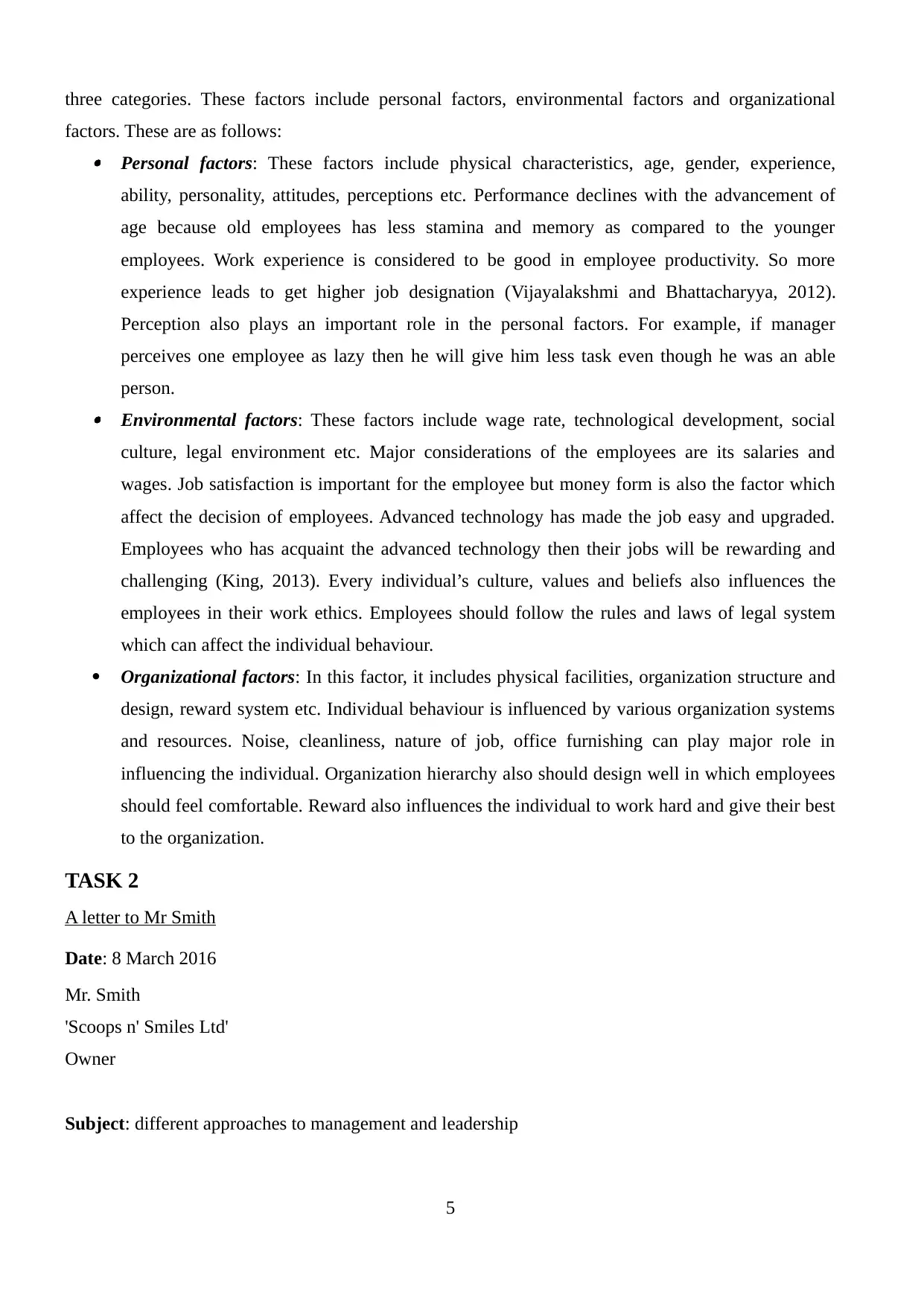
three categories. These factors include personal factors, environmental factors and organizational
factors. These are as follows: Personal factors: These factors include physical characteristics, age, gender, experience,
ability, personality, attitudes, perceptions etc. Performance declines with the advancement of
age because old employees has less stamina and memory as compared to the younger
employees. Work experience is considered to be good in employee productivity. So more
experience leads to get higher job designation (Vijayalakshmi and Bhattacharyya, 2012).
Perception also plays an important role in the personal factors. For example, if manager
perceives one employee as lazy then he will give him less task even though he was an able
person. Environmental factors: These factors include wage rate, technological development, social
culture, legal environment etc. Major considerations of the employees are its salaries and
wages. Job satisfaction is important for the employee but money form is also the factor which
affect the decision of employees. Advanced technology has made the job easy and upgraded.
Employees who has acquaint the advanced technology then their jobs will be rewarding and
challenging (King, 2013). Every individual’s culture, values and beliefs also influences the
employees in their work ethics. Employees should follow the rules and laws of legal system
which can affect the individual behaviour.
Organizational factors: In this factor, it includes physical facilities, organization structure and
design, reward system etc. Individual behaviour is influenced by various organization systems
and resources. Noise, cleanliness, nature of job, office furnishing can play major role in
influencing the individual. Organization hierarchy also should design well in which employees
should feel comfortable. Reward also influences the individual to work hard and give their best
to the organization.
TASK 2
A letter to Mr Smith
Date: 8 March 2016
Mr. Smith
'Scoops n' Smiles Ltd'
Owner
Subject: different approaches to management and leadership
5
factors. These are as follows: Personal factors: These factors include physical characteristics, age, gender, experience,
ability, personality, attitudes, perceptions etc. Performance declines with the advancement of
age because old employees has less stamina and memory as compared to the younger
employees. Work experience is considered to be good in employee productivity. So more
experience leads to get higher job designation (Vijayalakshmi and Bhattacharyya, 2012).
Perception also plays an important role in the personal factors. For example, if manager
perceives one employee as lazy then he will give him less task even though he was an able
person. Environmental factors: These factors include wage rate, technological development, social
culture, legal environment etc. Major considerations of the employees are its salaries and
wages. Job satisfaction is important for the employee but money form is also the factor which
affect the decision of employees. Advanced technology has made the job easy and upgraded.
Employees who has acquaint the advanced technology then their jobs will be rewarding and
challenging (King, 2013). Every individual’s culture, values and beliefs also influences the
employees in their work ethics. Employees should follow the rules and laws of legal system
which can affect the individual behaviour.
Organizational factors: In this factor, it includes physical facilities, organization structure and
design, reward system etc. Individual behaviour is influenced by various organization systems
and resources. Noise, cleanliness, nature of job, office furnishing can play major role in
influencing the individual. Organization hierarchy also should design well in which employees
should feel comfortable. Reward also influences the individual to work hard and give their best
to the organization.
TASK 2
A letter to Mr Smith
Date: 8 March 2016
Mr. Smith
'Scoops n' Smiles Ltd'
Owner
Subject: different approaches to management and leadership
5
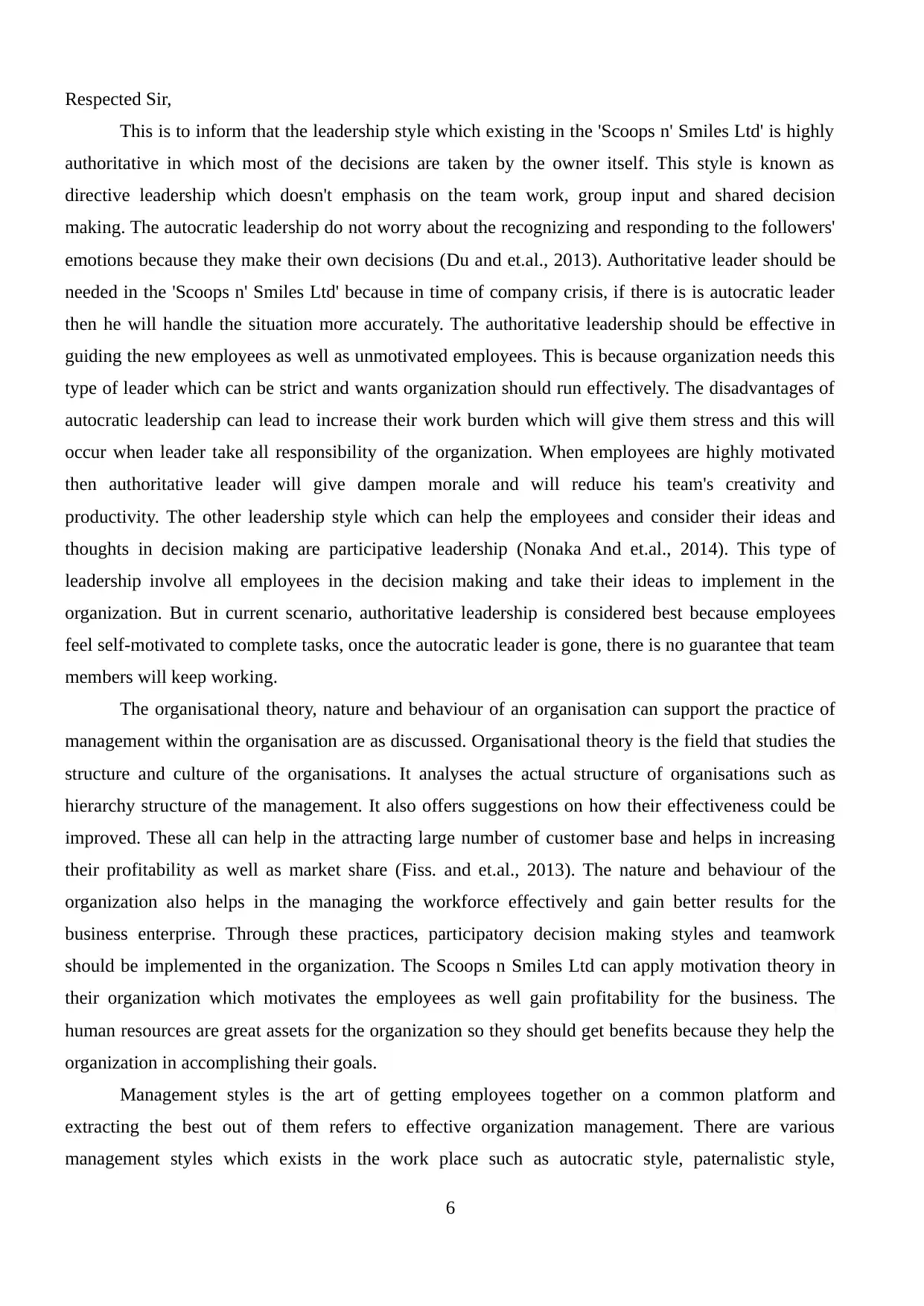
Respected Sir,
This is to inform that the leadership style which existing in the 'Scoops n' Smiles Ltd' is highly
authoritative in which most of the decisions are taken by the owner itself. This style is known as
directive leadership which doesn't emphasis on the team work, group input and shared decision
making. The autocratic leadership do not worry about the recognizing and responding to the followers'
emotions because they make their own decisions (Du and et.al., 2013). Authoritative leader should be
needed in the 'Scoops n' Smiles Ltd' because in time of company crisis, if there is is autocratic leader
then he will handle the situation more accurately. The authoritative leadership should be effective in
guiding the new employees as well as unmotivated employees. This is because organization needs this
type of leader which can be strict and wants organization should run effectively. The disadvantages of
autocratic leadership can lead to increase their work burden which will give them stress and this will
occur when leader take all responsibility of the organization. When employees are highly motivated
then authoritative leader will give dampen morale and will reduce his team's creativity and
productivity. The other leadership style which can help the employees and consider their ideas and
thoughts in decision making are participative leadership (Nonaka And et.al., 2014). This type of
leadership involve all employees in the decision making and take their ideas to implement in the
organization. But in current scenario, authoritative leadership is considered best because employees
feel self-motivated to complete tasks, once the autocratic leader is gone, there is no guarantee that team
members will keep working.
The organisational theory, nature and behaviour of an organisation can support the practice of
management within the organisation are as discussed. Organisational theory is the field that studies the
structure and culture of the organisations. It analyses the actual structure of organisations such as
hierarchy structure of the management. It also offers suggestions on how their effectiveness could be
improved. These all can help in the attracting large number of customer base and helps in increasing
their profitability as well as market share (Fiss. and et.al., 2013). The nature and behaviour of the
organization also helps in the managing the workforce effectively and gain better results for the
business enterprise. Through these practices, participatory decision making styles and teamwork
should be implemented in the organization. The Scoops n Smiles Ltd can apply motivation theory in
their organization which motivates the employees as well gain profitability for the business. The
human resources are great assets for the organization so they should get benefits because they help the
organization in accomplishing their goals.
Management styles is the art of getting employees together on a common platform and
extracting the best out of them refers to effective organization management. There are various
management styles which exists in the work place such as autocratic style, paternalistic style,
6
This is to inform that the leadership style which existing in the 'Scoops n' Smiles Ltd' is highly
authoritative in which most of the decisions are taken by the owner itself. This style is known as
directive leadership which doesn't emphasis on the team work, group input and shared decision
making. The autocratic leadership do not worry about the recognizing and responding to the followers'
emotions because they make their own decisions (Du and et.al., 2013). Authoritative leader should be
needed in the 'Scoops n' Smiles Ltd' because in time of company crisis, if there is is autocratic leader
then he will handle the situation more accurately. The authoritative leadership should be effective in
guiding the new employees as well as unmotivated employees. This is because organization needs this
type of leader which can be strict and wants organization should run effectively. The disadvantages of
autocratic leadership can lead to increase their work burden which will give them stress and this will
occur when leader take all responsibility of the organization. When employees are highly motivated
then authoritative leader will give dampen morale and will reduce his team's creativity and
productivity. The other leadership style which can help the employees and consider their ideas and
thoughts in decision making are participative leadership (Nonaka And et.al., 2014). This type of
leadership involve all employees in the decision making and take their ideas to implement in the
organization. But in current scenario, authoritative leadership is considered best because employees
feel self-motivated to complete tasks, once the autocratic leader is gone, there is no guarantee that team
members will keep working.
The organisational theory, nature and behaviour of an organisation can support the practice of
management within the organisation are as discussed. Organisational theory is the field that studies the
structure and culture of the organisations. It analyses the actual structure of organisations such as
hierarchy structure of the management. It also offers suggestions on how their effectiveness could be
improved. These all can help in the attracting large number of customer base and helps in increasing
their profitability as well as market share (Fiss. and et.al., 2013). The nature and behaviour of the
organization also helps in the managing the workforce effectively and gain better results for the
business enterprise. Through these practices, participatory decision making styles and teamwork
should be implemented in the organization. The Scoops n Smiles Ltd can apply motivation theory in
their organization which motivates the employees as well gain profitability for the business. The
human resources are great assets for the organization so they should get benefits because they help the
organization in accomplishing their goals.
Management styles is the art of getting employees together on a common platform and
extracting the best out of them refers to effective organization management. There are various
management styles which exists in the work place such as autocratic style, paternalistic style,
6
⊘ This is a preview!⊘
Do you want full access?
Subscribe today to unlock all pages.

Trusted by 1+ million students worldwide
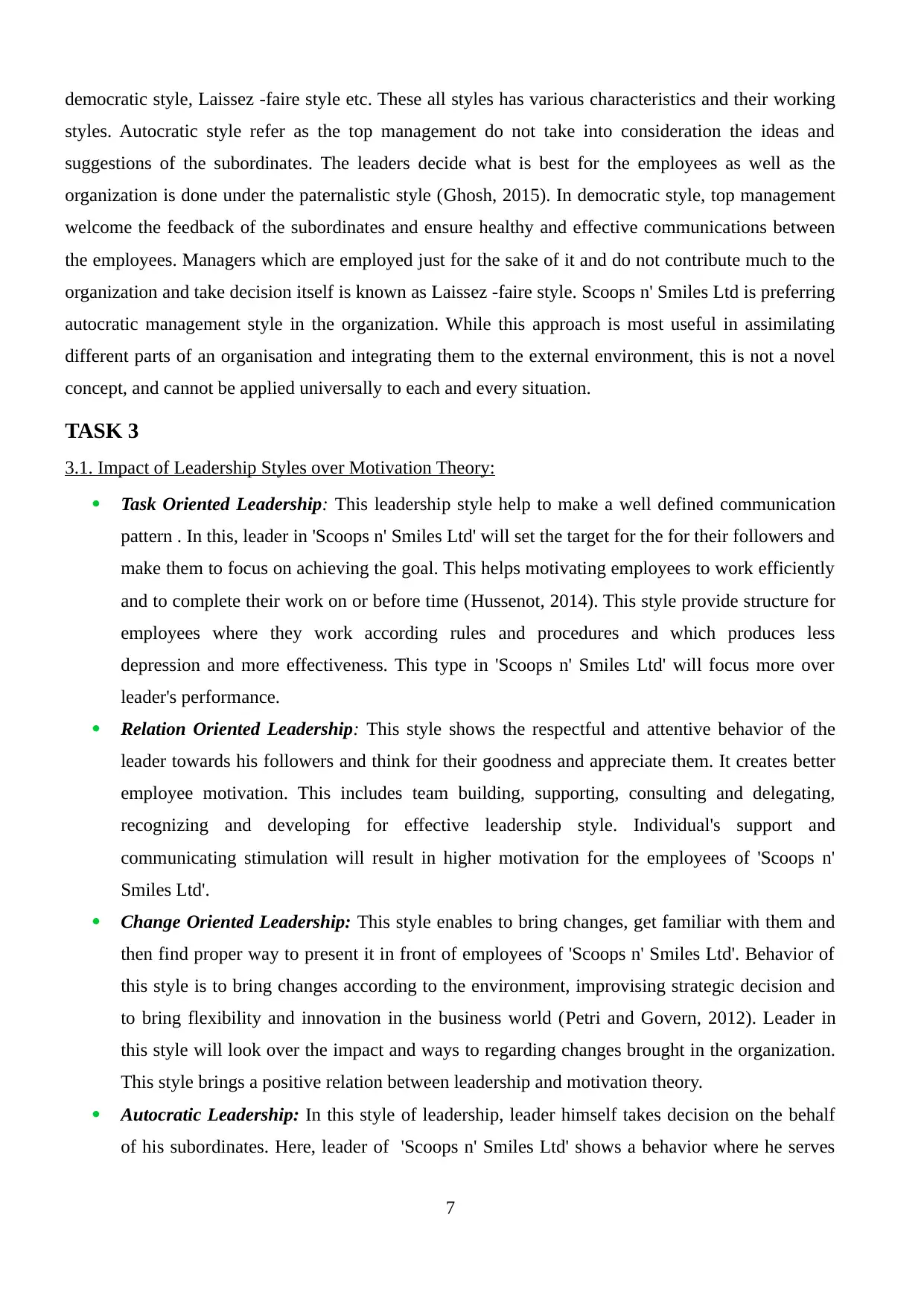
democratic style, Laissez -faire style etc. These all styles has various characteristics and their working
styles. Autocratic style refer as the top management do not take into consideration the ideas and
suggestions of the subordinates. The leaders decide what is best for the employees as well as the
organization is done under the paternalistic style (Ghosh, 2015). In democratic style, top management
welcome the feedback of the subordinates and ensure healthy and effective communications between
the employees. Managers which are employed just for the sake of it and do not contribute much to the
organization and take decision itself is known as Laissez -faire style. Scoops n' Smiles Ltd is preferring
autocratic management style in the organization. While this approach is most useful in assimilating
different parts of an organisation and integrating them to the external environment, this is not a novel
concept, and cannot be applied universally to each and every situation.
TASK 3
3.1. Impact of Leadership Styles over Motivation Theory:
Task Oriented Leadership: This leadership style help to make a well defined communication
pattern . In this, leader in 'Scoops n' Smiles Ltd' will set the target for the for their followers and
make them to focus on achieving the goal. This helps motivating employees to work efficiently
and to complete their work on or before time (Hussenot, 2014). This style provide structure for
employees where they work according rules and procedures and which produces less
depression and more effectiveness. This type in 'Scoops n' Smiles Ltd' will focus more over
leader's performance.
Relation Oriented Leadership: This style shows the respectful and attentive behavior of the
leader towards his followers and think for their goodness and appreciate them. It creates better
employee motivation. This includes team building, supporting, consulting and delegating,
recognizing and developing for effective leadership style. Individual's support and
communicating stimulation will result in higher motivation for the employees of 'Scoops n'
Smiles Ltd'.
Change Oriented Leadership: This style enables to bring changes, get familiar with them and
then find proper way to present it in front of employees of 'Scoops n' Smiles Ltd'. Behavior of
this style is to bring changes according to the environment, improvising strategic decision and
to bring flexibility and innovation in the business world (Petri and Govern, 2012). Leader in
this style will look over the impact and ways to regarding changes brought in the organization.
This style brings a positive relation between leadership and motivation theory.
Autocratic Leadership: In this style of leadership, leader himself takes decision on the behalf
of his subordinates. Here, leader of 'Scoops n' Smiles Ltd' shows a behavior where he serves
7
styles. Autocratic style refer as the top management do not take into consideration the ideas and
suggestions of the subordinates. The leaders decide what is best for the employees as well as the
organization is done under the paternalistic style (Ghosh, 2015). In democratic style, top management
welcome the feedback of the subordinates and ensure healthy and effective communications between
the employees. Managers which are employed just for the sake of it and do not contribute much to the
organization and take decision itself is known as Laissez -faire style. Scoops n' Smiles Ltd is preferring
autocratic management style in the organization. While this approach is most useful in assimilating
different parts of an organisation and integrating them to the external environment, this is not a novel
concept, and cannot be applied universally to each and every situation.
TASK 3
3.1. Impact of Leadership Styles over Motivation Theory:
Task Oriented Leadership: This leadership style help to make a well defined communication
pattern . In this, leader in 'Scoops n' Smiles Ltd' will set the target for the for their followers and
make them to focus on achieving the goal. This helps motivating employees to work efficiently
and to complete their work on or before time (Hussenot, 2014). This style provide structure for
employees where they work according rules and procedures and which produces less
depression and more effectiveness. This type in 'Scoops n' Smiles Ltd' will focus more over
leader's performance.
Relation Oriented Leadership: This style shows the respectful and attentive behavior of the
leader towards his followers and think for their goodness and appreciate them. It creates better
employee motivation. This includes team building, supporting, consulting and delegating,
recognizing and developing for effective leadership style. Individual's support and
communicating stimulation will result in higher motivation for the employees of 'Scoops n'
Smiles Ltd'.
Change Oriented Leadership: This style enables to bring changes, get familiar with them and
then find proper way to present it in front of employees of 'Scoops n' Smiles Ltd'. Behavior of
this style is to bring changes according to the environment, improvising strategic decision and
to bring flexibility and innovation in the business world (Petri and Govern, 2012). Leader in
this style will look over the impact and ways to regarding changes brought in the organization.
This style brings a positive relation between leadership and motivation theory.
Autocratic Leadership: In this style of leadership, leader himself takes decision on the behalf
of his subordinates. Here, leader of 'Scoops n' Smiles Ltd' shows a behavior where he serves
7
Paraphrase This Document
Need a fresh take? Get an instant paraphrase of this document with our AI Paraphraser
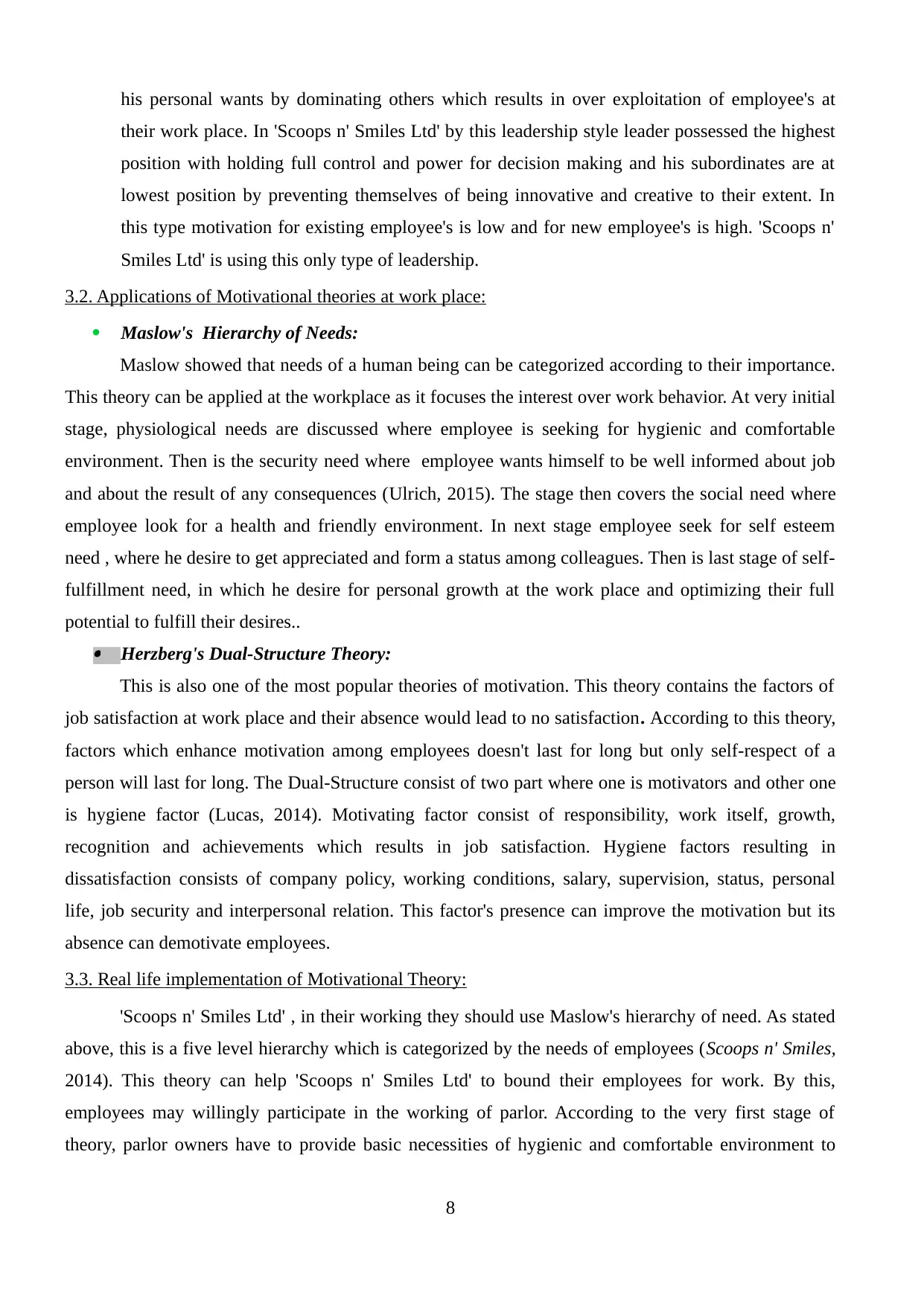
his personal wants by dominating others which results in over exploitation of employee's at
their work place. In 'Scoops n' Smiles Ltd' by this leadership style leader possessed the highest
position with holding full control and power for decision making and his subordinates are at
lowest position by preventing themselves of being innovative and creative to their extent. In
this type motivation for existing employee's is low and for new employee's is high. 'Scoops n'
Smiles Ltd' is using this only type of leadership.
3.2. Applications of Motivational theories at work place:
Maslow's Hierarchy of Needs:
Maslow showed that needs of a human being can be categorized according to their importance.
This theory can be applied at the workplace as it focuses the interest over work behavior. At very initial
stage, physiological needs are discussed where employee is seeking for hygienic and comfortable
environment. Then is the security need where employee wants himself to be well informed about job
and about the result of any consequences (Ulrich, 2015). The stage then covers the social need where
employee look for a health and friendly environment. In next stage employee seek for self esteem
need , where he desire to get appreciated and form a status among colleagues. Then is last stage of self-
fulfillment need, in which he desire for personal growth at the work place and optimizing their full
potential to fulfill their desires.. Herzberg's Dual-Structure Theory:
This is also one of the most popular theories of motivation. This theory contains the factors of
job satisfaction at work place and their absence would lead to no satisfaction. According to this theory,
factors which enhance motivation among employees doesn't last for long but only self-respect of a
person will last for long. The Dual-Structure consist of two part where one is motivators and other one
is hygiene factor (Lucas, 2014). Motivating factor consist of responsibility, work itself, growth,
recognition and achievements which results in job satisfaction. Hygiene factors resulting in
dissatisfaction consists of company policy, working conditions, salary, supervision, status, personal
life, job security and interpersonal relation. This factor's presence can improve the motivation but its
absence can demotivate employees.
3.3. Real life implementation of Motivational Theory:
'Scoops n' Smiles Ltd' , in their working they should use Maslow's hierarchy of need. As stated
above, this is a five level hierarchy which is categorized by the needs of employees (Scoops n' Smiles,
2014). This theory can help 'Scoops n' Smiles Ltd' to bound their employees for work. By this,
employees may willingly participate in the working of parlor. According to the very first stage of
theory, parlor owners have to provide basic necessities of hygienic and comfortable environment to
8
their work place. In 'Scoops n' Smiles Ltd' by this leadership style leader possessed the highest
position with holding full control and power for decision making and his subordinates are at
lowest position by preventing themselves of being innovative and creative to their extent. In
this type motivation for existing employee's is low and for new employee's is high. 'Scoops n'
Smiles Ltd' is using this only type of leadership.
3.2. Applications of Motivational theories at work place:
Maslow's Hierarchy of Needs:
Maslow showed that needs of a human being can be categorized according to their importance.
This theory can be applied at the workplace as it focuses the interest over work behavior. At very initial
stage, physiological needs are discussed where employee is seeking for hygienic and comfortable
environment. Then is the security need where employee wants himself to be well informed about job
and about the result of any consequences (Ulrich, 2015). The stage then covers the social need where
employee look for a health and friendly environment. In next stage employee seek for self esteem
need , where he desire to get appreciated and form a status among colleagues. Then is last stage of self-
fulfillment need, in which he desire for personal growth at the work place and optimizing their full
potential to fulfill their desires.. Herzberg's Dual-Structure Theory:
This is also one of the most popular theories of motivation. This theory contains the factors of
job satisfaction at work place and their absence would lead to no satisfaction. According to this theory,
factors which enhance motivation among employees doesn't last for long but only self-respect of a
person will last for long. The Dual-Structure consist of two part where one is motivators and other one
is hygiene factor (Lucas, 2014). Motivating factor consist of responsibility, work itself, growth,
recognition and achievements which results in job satisfaction. Hygiene factors resulting in
dissatisfaction consists of company policy, working conditions, salary, supervision, status, personal
life, job security and interpersonal relation. This factor's presence can improve the motivation but its
absence can demotivate employees.
3.3. Real life implementation of Motivational Theory:
'Scoops n' Smiles Ltd' , in their working they should use Maslow's hierarchy of need. As stated
above, this is a five level hierarchy which is categorized by the needs of employees (Scoops n' Smiles,
2014). This theory can help 'Scoops n' Smiles Ltd' to bound their employees for work. By this,
employees may willingly participate in the working of parlor. According to the very first stage of
theory, parlor owners have to provide basic necessities of hygienic and comfortable environment to
8
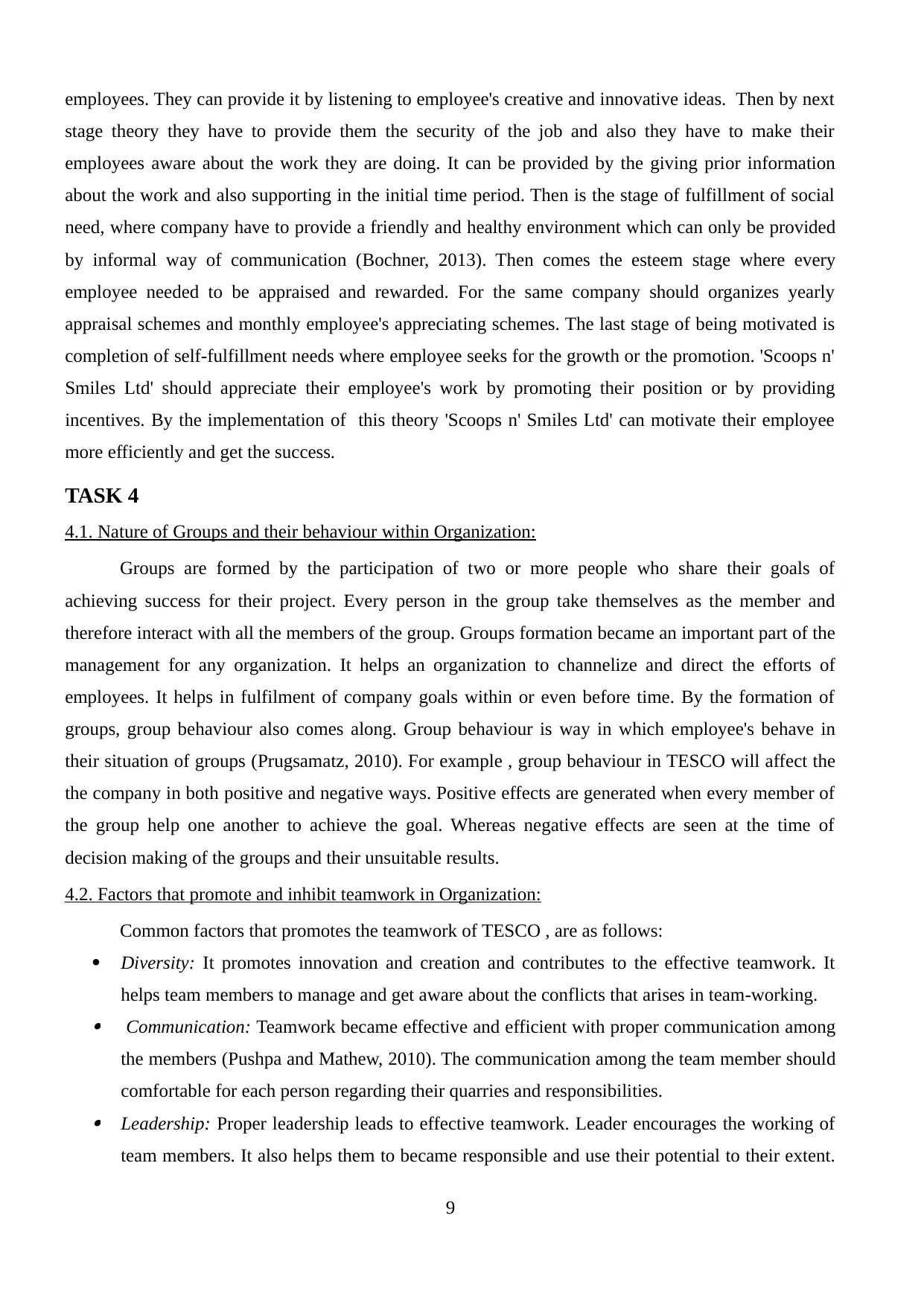
employees. They can provide it by listening to employee's creative and innovative ideas. Then by next
stage theory they have to provide them the security of the job and also they have to make their
employees aware about the work they are doing. It can be provided by the giving prior information
about the work and also supporting in the initial time period. Then is the stage of fulfillment of social
need, where company have to provide a friendly and healthy environment which can only be provided
by informal way of communication (Bochner, 2013). Then comes the esteem stage where every
employee needed to be appraised and rewarded. For the same company should organizes yearly
appraisal schemes and monthly employee's appreciating schemes. The last stage of being motivated is
completion of self-fulfillment needs where employee seeks for the growth or the promotion. 'Scoops n'
Smiles Ltd' should appreciate their employee's work by promoting their position or by providing
incentives. By the implementation of this theory 'Scoops n' Smiles Ltd' can motivate their employee
more efficiently and get the success.
TASK 4
4.1. Nature of Groups and their behaviour within Organization:
Groups are formed by the participation of two or more people who share their goals of
achieving success for their project. Every person in the group take themselves as the member and
therefore interact with all the members of the group. Groups formation became an important part of the
management for any organization. It helps an organization to channelize and direct the efforts of
employees. It helps in fulfilment of company goals within or even before time. By the formation of
groups, group behaviour also comes along. Group behaviour is way in which employee's behave in
their situation of groups (Prugsamatz, 2010). For example , group behaviour in TESCO will affect the
the company in both positive and negative ways. Positive effects are generated when every member of
the group help one another to achieve the goal. Whereas negative effects are seen at the time of
decision making of the groups and their unsuitable results.
4.2. Factors that promote and inhibit teamwork in Organization:
Common factors that promotes the teamwork of TESCO , are as follows:
Diversity: It promotes innovation and creation and contributes to the effective teamwork. It
helps team members to manage and get aware about the conflicts that arises in team-working. Communication: Teamwork became effective and efficient with proper communication among
the members (Pushpa and Mathew, 2010). The communication among the team member should
comfortable for each person regarding their quarries and responsibilities. Leadership: Proper leadership leads to effective teamwork. Leader encourages the working of
team members. It also helps them to became responsible and use their potential to their extent.
9
stage theory they have to provide them the security of the job and also they have to make their
employees aware about the work they are doing. It can be provided by the giving prior information
about the work and also supporting in the initial time period. Then is the stage of fulfillment of social
need, where company have to provide a friendly and healthy environment which can only be provided
by informal way of communication (Bochner, 2013). Then comes the esteem stage where every
employee needed to be appraised and rewarded. For the same company should organizes yearly
appraisal schemes and monthly employee's appreciating schemes. The last stage of being motivated is
completion of self-fulfillment needs where employee seeks for the growth or the promotion. 'Scoops n'
Smiles Ltd' should appreciate their employee's work by promoting their position or by providing
incentives. By the implementation of this theory 'Scoops n' Smiles Ltd' can motivate their employee
more efficiently and get the success.
TASK 4
4.1. Nature of Groups and their behaviour within Organization:
Groups are formed by the participation of two or more people who share their goals of
achieving success for their project. Every person in the group take themselves as the member and
therefore interact with all the members of the group. Groups formation became an important part of the
management for any organization. It helps an organization to channelize and direct the efforts of
employees. It helps in fulfilment of company goals within or even before time. By the formation of
groups, group behaviour also comes along. Group behaviour is way in which employee's behave in
their situation of groups (Prugsamatz, 2010). For example , group behaviour in TESCO will affect the
the company in both positive and negative ways. Positive effects are generated when every member of
the group help one another to achieve the goal. Whereas negative effects are seen at the time of
decision making of the groups and their unsuitable results.
4.2. Factors that promote and inhibit teamwork in Organization:
Common factors that promotes the teamwork of TESCO , are as follows:
Diversity: It promotes innovation and creation and contributes to the effective teamwork. It
helps team members to manage and get aware about the conflicts that arises in team-working. Communication: Teamwork became effective and efficient with proper communication among
the members (Pushpa and Mathew, 2010). The communication among the team member should
comfortable for each person regarding their quarries and responsibilities. Leadership: Proper leadership leads to effective teamwork. Leader encourages the working of
team members. It also helps them to became responsible and use their potential to their extent.
9
⊘ This is a preview!⊘
Do you want full access?
Subscribe today to unlock all pages.

Trusted by 1+ million students worldwide
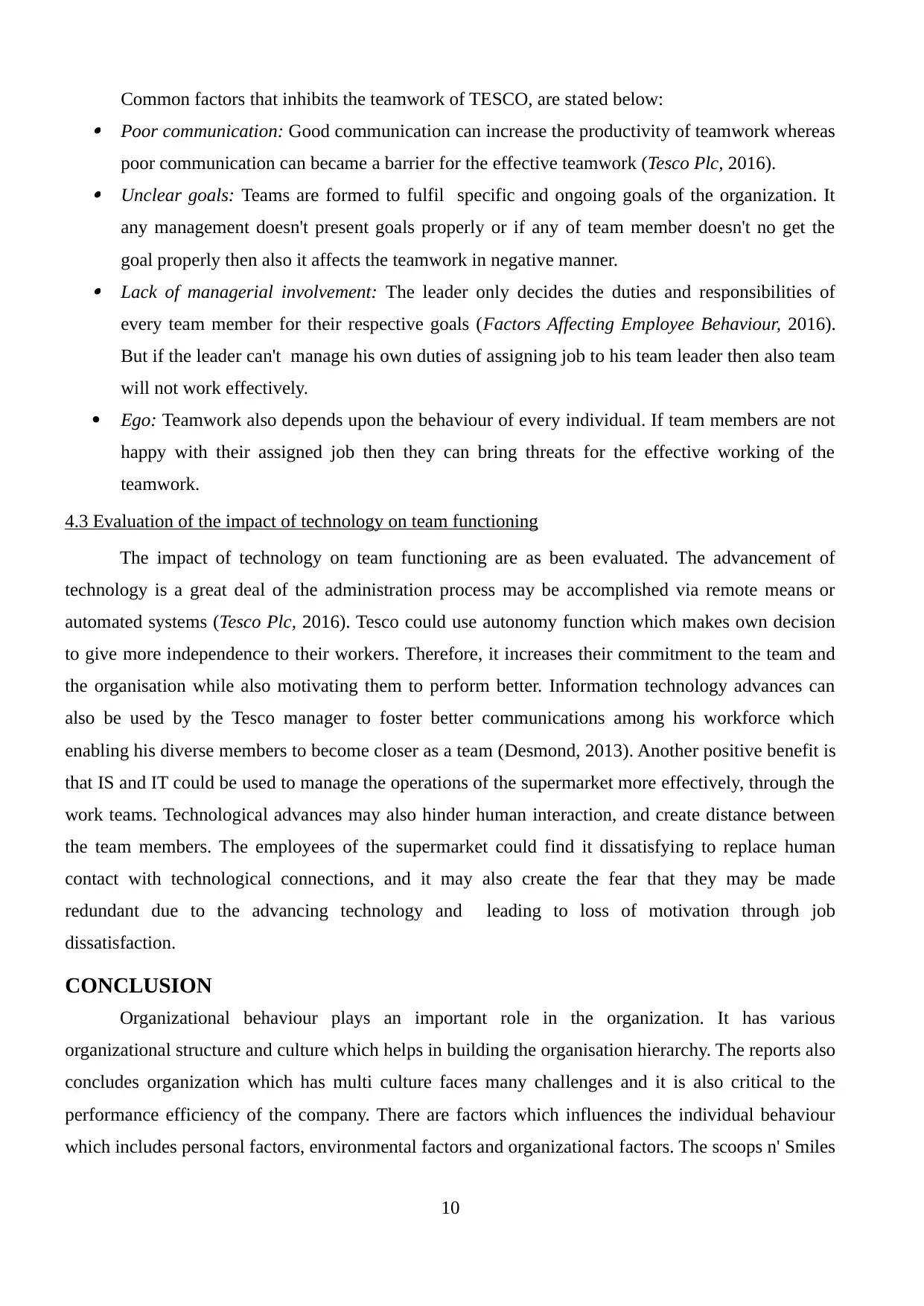
Common factors that inhibits the teamwork of TESCO, are stated below: Poor communication: Good communication can increase the productivity of teamwork whereas
poor communication can became a barrier for the effective teamwork (Tesco Plc, 2016). Unclear goals: Teams are formed to fulfil specific and ongoing goals of the organization. It
any management doesn't present goals properly or if any of team member doesn't no get the
goal properly then also it affects the teamwork in negative manner. Lack of managerial involvement: The leader only decides the duties and responsibilities of
every team member for their respective goals (Factors Affecting Employee Behaviour, 2016).
But if the leader can't manage his own duties of assigning job to his team leader then also team
will not work effectively.
Ego: Teamwork also depends upon the behaviour of every individual. If team members are not
happy with their assigned job then they can bring threats for the effective working of the
teamwork.
4.3 Evaluation of the impact of technology on team functioning
The impact of technology on team functioning are as been evaluated. The advancement of
technology is a great deal of the administration process may be accomplished via remote means or
automated systems (Tesco Plc, 2016). Tesco could use autonomy function which makes own decision
to give more independence to their workers. Therefore, it increases their commitment to the team and
the organisation while also motivating them to perform better. Information technology advances can
also be used by the Tesco manager to foster better communications among his workforce which
enabling his diverse members to become closer as a team (Desmond, 2013). Another positive benefit is
that IS and IT could be used to manage the operations of the supermarket more effectively, through the
work teams. Technological advances may also hinder human interaction, and create distance between
the team members. The employees of the supermarket could find it dissatisfying to replace human
contact with technological connections, and it may also create the fear that they may be made
redundant due to the advancing technology and leading to loss of motivation through job
dissatisfaction.
CONCLUSION
Organizational behaviour plays an important role in the organization. It has various
organizational structure and culture which helps in building the organisation hierarchy. The reports also
concludes organization which has multi culture faces many challenges and it is also critical to the
performance efficiency of the company. There are factors which influences the individual behaviour
which includes personal factors, environmental factors and organizational factors. The scoops n' Smiles
10
poor communication can became a barrier for the effective teamwork (Tesco Plc, 2016). Unclear goals: Teams are formed to fulfil specific and ongoing goals of the organization. It
any management doesn't present goals properly or if any of team member doesn't no get the
goal properly then also it affects the teamwork in negative manner. Lack of managerial involvement: The leader only decides the duties and responsibilities of
every team member for their respective goals (Factors Affecting Employee Behaviour, 2016).
But if the leader can't manage his own duties of assigning job to his team leader then also team
will not work effectively.
Ego: Teamwork also depends upon the behaviour of every individual. If team members are not
happy with their assigned job then they can bring threats for the effective working of the
teamwork.
4.3 Evaluation of the impact of technology on team functioning
The impact of technology on team functioning are as been evaluated. The advancement of
technology is a great deal of the administration process may be accomplished via remote means or
automated systems (Tesco Plc, 2016). Tesco could use autonomy function which makes own decision
to give more independence to their workers. Therefore, it increases their commitment to the team and
the organisation while also motivating them to perform better. Information technology advances can
also be used by the Tesco manager to foster better communications among his workforce which
enabling his diverse members to become closer as a team (Desmond, 2013). Another positive benefit is
that IS and IT could be used to manage the operations of the supermarket more effectively, through the
work teams. Technological advances may also hinder human interaction, and create distance between
the team members. The employees of the supermarket could find it dissatisfying to replace human
contact with technological connections, and it may also create the fear that they may be made
redundant due to the advancing technology and leading to loss of motivation through job
dissatisfaction.
CONCLUSION
Organizational behaviour plays an important role in the organization. It has various
organizational structure and culture which helps in building the organisation hierarchy. The reports also
concludes organization which has multi culture faces many challenges and it is also critical to the
performance efficiency of the company. There are factors which influences the individual behaviour
which includes personal factors, environmental factors and organizational factors. The scoops n' Smiles
10
Paraphrase This Document
Need a fresh take? Get an instant paraphrase of this document with our AI Paraphraser
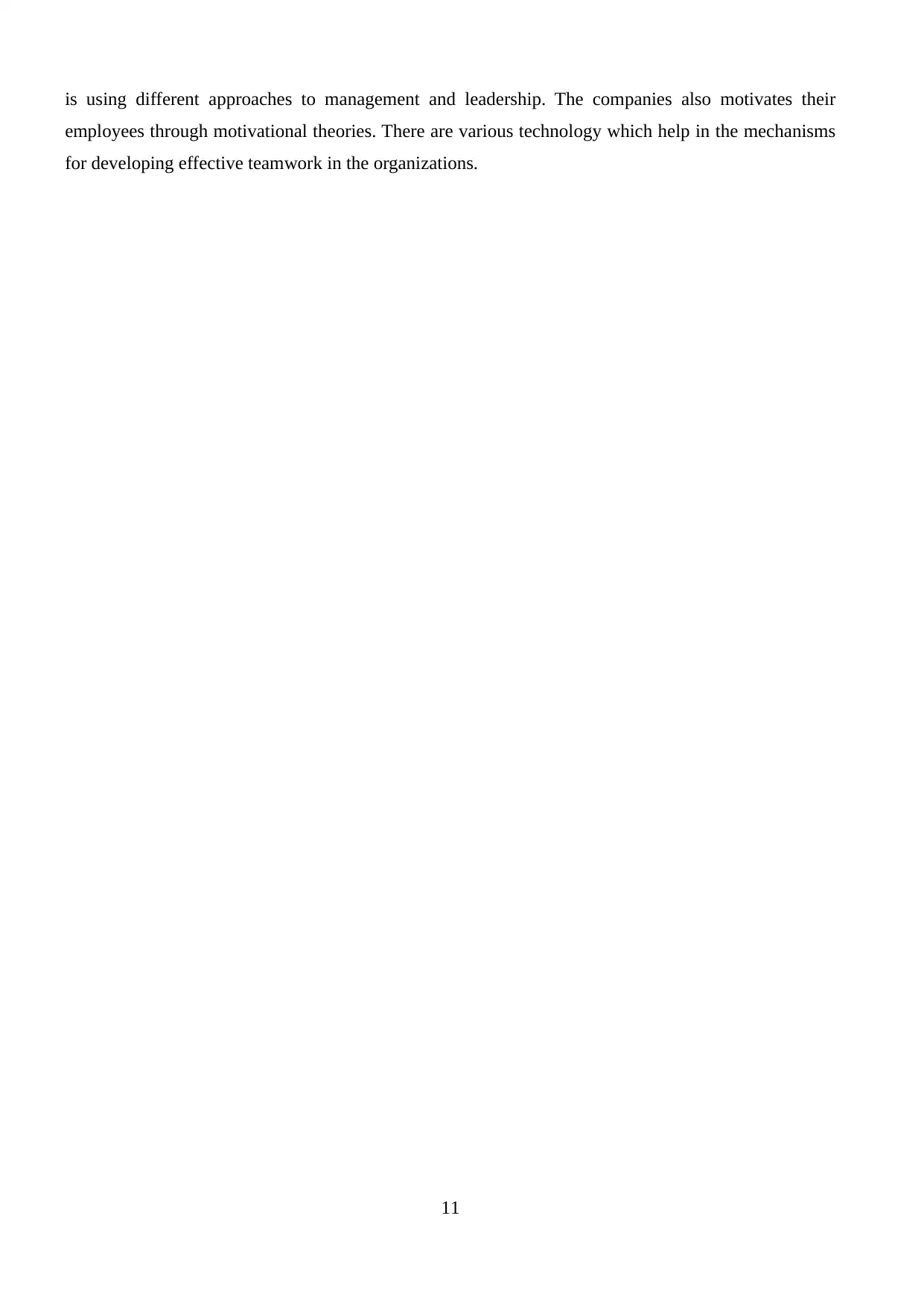
is using different approaches to management and leadership. The companies also motivates their
employees through motivational theories. There are various technology which help in the mechanisms
for developing effective teamwork in the organizations.
11
employees through motivational theories. There are various technology which help in the mechanisms
for developing effective teamwork in the organizations.
11
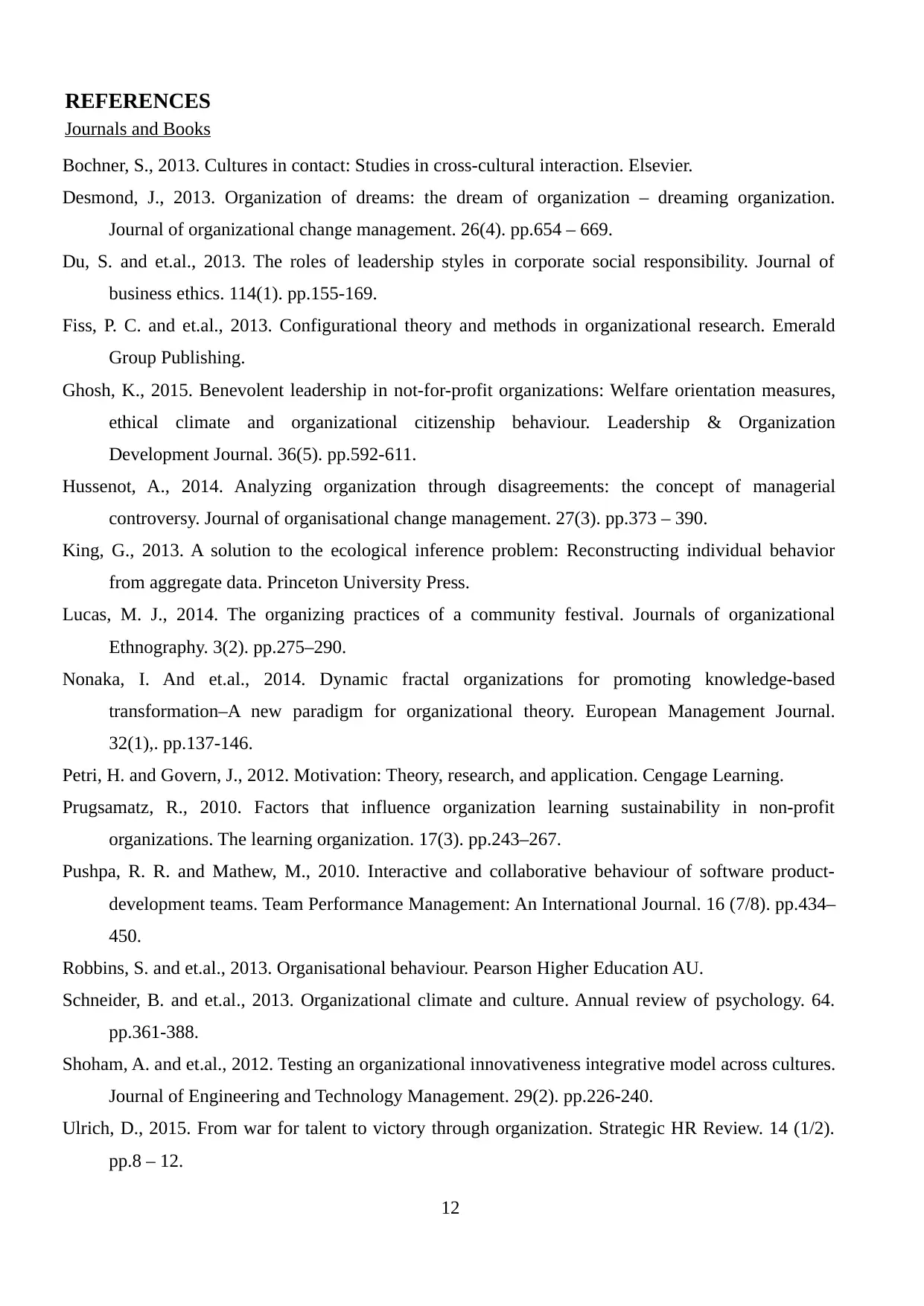
REFERENCES
Journals and Books
Bochner, S., 2013. Cultures in contact: Studies in cross-cultural interaction. Elsevier.
Desmond, J., 2013. Organization of dreams: the dream of organization – dreaming organization.
Journal of organizational change management. 26(4). pp.654 – 669.
Du, S. and et.al., 2013. The roles of leadership styles in corporate social responsibility. Journal of
business ethics. 114(1). pp.155-169.
Fiss, P. C. and et.al., 2013. Configurational theory and methods in organizational research. Emerald
Group Publishing.
Ghosh, K., 2015. Benevolent leadership in not-for-profit organizations: Welfare orientation measures,
ethical climate and organizational citizenship behaviour. Leadership & Organization
Development Journal. 36(5). pp.592-611.
Hussenot, A., 2014. Analyzing organization through disagreements: the concept of managerial
controversy. Journal of organisational change management. 27(3). pp.373 – 390.
King, G., 2013. A solution to the ecological inference problem: Reconstructing individual behavior
from aggregate data. Princeton University Press.
Lucas, M. J., 2014. The organizing practices of a community festival. Journals of organizational
Ethnography. 3(2). pp.275–290.
Nonaka, I. And et.al., 2014. Dynamic fractal organizations for promoting knowledge-based
transformation–A new paradigm for organizational theory. European Management Journal.
32(1),. pp.137-146.
Petri, H. and Govern, J., 2012. Motivation: Theory, research, and application. Cengage Learning.
Prugsamatz, R., 2010. Factors that influence organization learning sustainability in non‐profit
organizations. The learning organization. 17(3). pp.243–267.
Pushpa, R. R. and Mathew, M., 2010. Interactive and collaborative behaviour of software product‐
development teams. Team Performance Management: An International Journal. 16 (7/8). pp.434–
450.
Robbins, S. and et.al., 2013. Organisational behaviour. Pearson Higher Education AU.
Schneider, B. and et.al., 2013. Organizational climate and culture. Annual review of psychology. 64.
pp.361-388.
Shoham, A. and et.al., 2012. Testing an organizational innovativeness integrative model across cultures.
Journal of Engineering and Technology Management. 29(2). pp.226-240.
Ulrich, D., 2015. From war for talent to victory through organization. Strategic HR Review. 14 (1/2).
pp.8 – 12.
12
Journals and Books
Bochner, S., 2013. Cultures in contact: Studies in cross-cultural interaction. Elsevier.
Desmond, J., 2013. Organization of dreams: the dream of organization – dreaming organization.
Journal of organizational change management. 26(4). pp.654 – 669.
Du, S. and et.al., 2013. The roles of leadership styles in corporate social responsibility. Journal of
business ethics. 114(1). pp.155-169.
Fiss, P. C. and et.al., 2013. Configurational theory and methods in organizational research. Emerald
Group Publishing.
Ghosh, K., 2015. Benevolent leadership in not-for-profit organizations: Welfare orientation measures,
ethical climate and organizational citizenship behaviour. Leadership & Organization
Development Journal. 36(5). pp.592-611.
Hussenot, A., 2014. Analyzing organization through disagreements: the concept of managerial
controversy. Journal of organisational change management. 27(3). pp.373 – 390.
King, G., 2013. A solution to the ecological inference problem: Reconstructing individual behavior
from aggregate data. Princeton University Press.
Lucas, M. J., 2014. The organizing practices of a community festival. Journals of organizational
Ethnography. 3(2). pp.275–290.
Nonaka, I. And et.al., 2014. Dynamic fractal organizations for promoting knowledge-based
transformation–A new paradigm for organizational theory. European Management Journal.
32(1),. pp.137-146.
Petri, H. and Govern, J., 2012. Motivation: Theory, research, and application. Cengage Learning.
Prugsamatz, R., 2010. Factors that influence organization learning sustainability in non‐profit
organizations. The learning organization. 17(3). pp.243–267.
Pushpa, R. R. and Mathew, M., 2010. Interactive and collaborative behaviour of software product‐
development teams. Team Performance Management: An International Journal. 16 (7/8). pp.434–
450.
Robbins, S. and et.al., 2013. Organisational behaviour. Pearson Higher Education AU.
Schneider, B. and et.al., 2013. Organizational climate and culture. Annual review of psychology. 64.
pp.361-388.
Shoham, A. and et.al., 2012. Testing an organizational innovativeness integrative model across cultures.
Journal of Engineering and Technology Management. 29(2). pp.226-240.
Ulrich, D., 2015. From war for talent to victory through organization. Strategic HR Review. 14 (1/2).
pp.8 – 12.
12
⊘ This is a preview!⊘
Do you want full access?
Subscribe today to unlock all pages.

Trusted by 1+ million students worldwide
1 out of 14
Related Documents
Your All-in-One AI-Powered Toolkit for Academic Success.
+13062052269
info@desklib.com
Available 24*7 on WhatsApp / Email
![[object Object]](/_next/static/media/star-bottom.7253800d.svg)
Unlock your academic potential
Copyright © 2020–2025 A2Z Services. All Rights Reserved. Developed and managed by ZUCOL.





